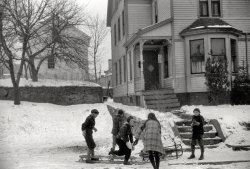
MAY CONTAIN NUTS

Search Shorpy
SHORPY ART

Framed or unframed, desk size to sofa size, printed by us in Arizona and Alabama since 2007. Explore now.
Join and Share
Ad-Free Shorpy
Shorpy is funded by you. Patreon contributors get an ad-free experience.
Learn more.

Recent comments
- Button It Up
- And with an eye on the time ...
- Working in an enclosed ashtray
- Rear View Mirror?
- Tobacco cam
- Basic fact I learned only later in life
- Put a Lid on it!
- Pinstripes in the Tower
- Sound enhancement
- 3438 in '38
- Second Career
- Their days are numbered
- Only the Sensor
- Train control mechanism
- Rarest of the Rare?? & Classy 3400 Class
- Control Mechanism
- Those standpipes
- Wrenches
- International D-40 I believe
- Job prospects
- You had me at Train
- Land of the free
- Broad-Exchange Bldg
- Parking innovation
- The old block
- "Peck turned a sweet propeller"
- National Bank Building
- Notch shot
- Straight ahead (right, left, left, right)
- Ship lifespans
Member Photos
The Shorpy
Printporium
Printporium
Search Shorpy
Search results -- 30 results per page
- Pills & Potions: 1942
- ... Case of the Rusted Room," first published in 1937 as a Clue Club Mystery, is a golden-age British whodunit by the prolific ... long stem cigarette holder and maybe time travel back to 1937.
Carboy The large bottle on the top shelf with hoses coming out, in ... Posted by Dave - 05/17/2019 - 5:55pm -
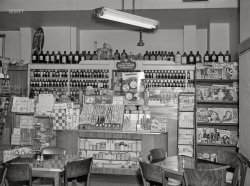
- Old Amsterdam: 1941
- ... what year? Absolutely love this site.
My guess is 1937.
Street sign hiding digit Taxi office downstairs and call 666? ... Posted by Dave - 09/09/2013 - 10:21am -
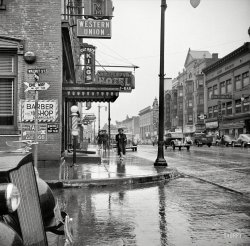
- Greyhound: 1938
- ... ( Yellow Coach history ). You can read the entire 1937 patent and see additional drawings here.
(click to ... Posted by Dave - 08/28/2012 - 1:40pm -
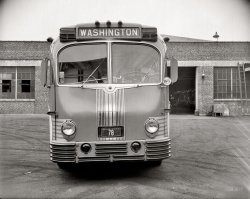
- West Street Story: 1912
- ... steamboats appear to be Fall River Line steamers. Up until 1937, the night boats of the Fall River Line were the preferred way to travel ... Posted by Dave - 07/18/2012 - 7:01pm -
![West Street Story: 1912 New York circa 1912. "West Street north from the Battery." An amazing view of the Hudson River piers from the foot of Manhattan centered by the West Street Building, which sustained grave damage a decade ago when the south tower of the World Trade Center collapsed; to east is the massive Hudson Terminal, and faintly visible through the haze is the Metropolitan Life tower. Note the ant-like profusion of horse wagons along West Street. This 8x10 glass negative was exposed from the Whitehall Building annex just south of today's Battery Park City and World Financial Center. The view up West Street and 11th Avenue is continued here at the Chelsea Piers. Detroit Publishing Co. View full size.
Best of the BestThis photo will become my "forever" all time favorite. It evokes history at so many levels. Amazingly, the two bridges that cross West Street are in extreme close proximity to those that connected the World Trade Center to The World Financial Center at Battery Park City. Actually the northern one looks like it is in exactly the same place! All I can do is stare and marvel at this gem that we are lucky enough to view. Thanks Dave/Shorpy
West Street BuildingIt is absolutely incredible to see the West Street Building standing in so isolated a position - yet it is barely a quarter-mile away from Broadway! Such were the contours of real estate values in Lower Manhattan a century ago. The West Street Building (1906-1907) was designed by Cass Gilbert; as his first "Gothic" skyscraper, it became the model for his more famous Woolworth Building of 1911-1913. It is believed that Frank W. Woolworth chose Gilbert as his architect largely because he liked what he saw on West Street.
!!Anazing.
[Jawohl. - Dave]
Whitehall StreetA few personal things come to mind when I read that The Whitehall Building was where this magnificent 1912 photo was taken. First, 39 Whitehall Street, was the building where I, and probably a million others were inducted into the US Army. The date I was there, October 8, 1956 and another momentous event was happening at the World Series in Yankee Stadium, Don Larsen pitched a perfect game.
Fast forward to 1995 and my wife and I are at the Whitehall Building looking at the Whitehall Club as a venue for my youngest daughter's wedding. The club occupied the entire top floor of the building with unobstructed views in all 4 directions. The views of the city, the Hudson River and the Statue of Liberty were just amazing. We didn't use that setting, because on a Saturday night, that part of town is usually deserted.
A REAL SeaportThis is wonderful evidence that, indeed, NY was once a great seaport. Look at all the piers with so much activity!
Fall River Line Steamers?The two large steamboats appear to be Fall River Line steamers. Up until 1937, the night boats of the Fall River Line were the preferred way to travel between NYC and Boston. A "boat train" met the boat in Fall River, MA early each morning.
Can anyone identify these steamboats? The far one seems to me to be the "Commonwealth".
(The Gallery, Boats & Bridges, DPC, NYC)](https://www.shorpy.com/files/images/SHORPY_4a25597a.thumbnail.jpg)
- As Advertised: 1939
- ... of anti-dandruff shampoos.
Going Viral From a 1937 TIME magazine article: “The 541 cigar stores of United Cigar-Whelan ... Posted by Dave - 05/15/2019 - 8:30pm -
![As Advertised: 1939 Spring 1939. "Drugstore window in Washington, D.C." Medium format acetate negative by David Moffat Myers for the Farm Security Administration. View full size.
Fingers of FearFrom the Amazon description of the book in the display window:
Ruined in the stock market crash of 1929, Selden Seaforth is on the verge of homelessness and starvation when he gets a lucky break: an old school friend, Ormond Ormes, hires him to catalogue the collection of rare books in the library at the mansion of Ormesby.
The mansion has a reputation for being haunted by ghosts, but Seaforth quickly finds out that ghosts are the least of his worries: the house is also inhabited by a bizarre family of madwomen, not to mention possibly vampires, werewolves, and the undead ...
[J.U. Nicolson was evidently big on alliteration. - Dave]
Inflation!I love these old store photos. Shows you how much inflation we have really had.
National brandsI'm not quite 70 but I recognize two products in the window. They're both at left: Lavoris, which I remember as the palatable mouthwash, as opposed to the intensely medicinal Listerine. The other is Castoria, which I vaguely recall, only from TV commercials, as Fletcher's Castoria.
Vitamin GWe call it riboflavin these days.
Not so cheapThe bottle of vitamins at $1.49 would go for almost $26 today, and $18 for the 98 cent pan.
As advertised -- Don't take our word for itOf course everyone will remark on the prices, but I notice there's not a single brand name in the whole store window (not the signs in the window, the window itself) that I recognize and I'm 70, so it's not like they are before my time.
I do like how they have posted the newspaper ad in the window along with the items advertised so that you can know you are getting the advertised price.
I give those 98-cent drugstore frypans about a week to last.
Now if I could just figure out what a "public telephone" was --
Try to find oneA public telephone, that is.
What the world needs... is a good five-cent cigar at 25 for 69 cents!
Related to United Cigars - and Marvel Comics!Interesting history of Whelan Drugs: https://en.wikipedia.org/wiki/United_Cigar_Stores
RelativityAccording to one obscure chart I found, the average annual salary for a public school teacher (for example) in Washington DC in 1939 was $2,350.
[Indeed. Relative to 1939, the number of hours (or minutes) the average person has to work in 2019 to buy something like a toothbrush or a whisk broom is so inconsequential, no store would bother advertising them, much less create a window display. - Dave]
Pipe toolsThose three-part items (reamer, tamper, pick) for 10¢ or 25¢, lower right, between what I take to be zippered pipe/tobacco pouches for a buck.
Box of 25 cigars for 69¢At that price, I’d resume smoking. Also, I’ll take one of those whisk brooms for a dime, please.
A drugstore!!I've noticed Shorpy has not featured drugstore photos recently, so I was delighted to see this one. Thanks! Also, I wonder when "films" lost the "s"? I presume the word refers to the item you put into a camera and took back to have developed.
Another label recognizedI also recognize the Fitch's Shampoo. That line of products was a staple in the barber shop when I was a kid. Fred Fitch also developed one of the first types of anti-dandruff shampoos.
Going Viral From a 1937 TIME magazine article: “The 541 cigar stores of United Cigar-Whelan Stores Corp., which dot the country like an attack of measles, have long been filled to bursting with Mickey Mouse watches, G-Man automatics, shoe trees ... ”
Whelan's Drugs
Such a DealEven adjusted for inflation those whisk brooms are a deal at $1.84 in today's dollars. Cheapest whisk brooms I could find on Amazon cost $4.32.
[$2.83 at Walmart. - Dave]
First EditionsAt least four of the books shown are still in print. I think I have a couple in my library from roughly the date of this photo.
(The Gallery, D.C., David Myers, Stores & Markets)](https://www.shorpy.com/files/images/SHORPY-8b15284a.thumbnail.jpg)
- Beer Boulevard: 1938
- ... unionizing. The decision was one of two in early spring 1937 that signaled President Roosevelt (and a switch by Justice Owen Roberts) ... blast furnace.
Ford country L-R: 1931 model A Ford; 1937 V8 rear view; Ford signs and lamps. The only tractor available in 1938 was ... Posted by Dave - 11/26/2017 - 12:49pm -
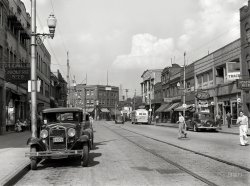
- Combat Fighters: 1941
- ... Dell's The Comics, issue No. 1, with a cover date of March 1937. In those days, comic books were usually collections of previously printed ... Posted by Dave - 09/10/2013 - 12:35pm -
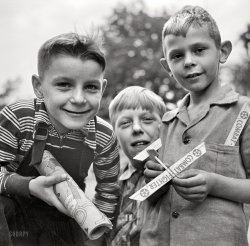
- Camera Craft: 1938
- ... by Camera Craft Publishing Company in San Francisco in 1937. A September 1981 article in Popular Photography noted that Champlin ... unchanged after almost 80 years!
Popular Photography 1937-2017 Camera Craft may still be publishing but Popular Photography ... Posted by Dave - 04/07/2017 - 9:06am -
![Camera Craft: 1938 April 1, 1938. San Francisco. "Camera Craft store, 425 Bush Street. Mr. E.R. Young." 8x10 inch acetate negative by Moulin Studios. View full size.
Elementary PhotographyThoroughly Stimulating, Expertly Written. For the Student, the Club Member, and the Amateur Photographer. By C.B. Neblette, Frederick W. Brehm, and Everett L. Priest (Macmillan, 1936). Under glass on the left, and in the middle bookshelf on the right, under the heading Latest Photographic Publications.
A professional and hobbyist dreamThis must be the most exciting camera store I have seen. So many periodicals. Looks like a hobby I would totally take up. Photography today means a smartphone app and a YouTube "how-to" video. Not nearly as interesting at all.
Looks familiarThis looks pretty much identical to any of the many Embarcadero photo stores I recall seeing during my visits there. But no doubt lacking the ridiculous markups and high-pressure salesmen of the more recent establishments.
Champlin On Fine GrainBy Harry Champlin, published by Camera Craft Publishing Company in San Francisco in 1937. A September 1981 article in Popular Photography noted that Champlin “took a dim view” of the future of 35mm film since it was too small for “the exacting demands of commercial photography and newspaper work.” He predicted 70mm as the new standard.
A Dearth of CamerasFor a camera store I certainly don't see many.
[Camera Craft was a publishing company. -Dave]
Brand NewThat looks like my Solar brand enlarger head behind the Popular Photography mag.
Camera stores!Isn't it odd that the photo hobby has changed so much? In my area, I would visit Penn Camera, Ritz Camera, and Industrial Photo every week. Didn't need anything. Just hanging out with my friends who worked there and messing around.
Days gone by. I used to love hanging around typewriter and watch repair shops, too. Chatting with folks with specialized, exact knowledge and geeking out.
Those days were such fun.
Where's the 'Phone?It's at the rear of the store, attached to a set of shelves. It appears to be a Western Electric Model 211 Spacesaver, and in this store that really is a plus.
When I was 12 my father gave me an Australian Kodak contact print set to make my own photos. It included a safe light, developing tank, trays, paper and chemicals to learn photo processing and printing. I later belonged to a camera club at school, and as an adult acquired an enlarger. I made my own prints in B&W for many years, but never graduated to colour. The enlarger resides in my attic since I went digital. I can now scan my old B&W negatives, and process them on my computer without all the liquids, fumes, etc. But I do miss the experience of visiting the camera store to stock up on supplies.
Camera Craft Still being published. Or rather being published again.
http://cameracraft.online/
Clamp lightsStill unchanged after almost 80 years!
Popular Photography 1937-2017Camera Craft may still be publishing but Popular Photography (bottom of the magazine rack) just shut down.
The Kodak LetterCurious about the "Kodak Letter" poster partly seen on the upper right, I found it was a 1918 magazine ad encouraging people to send photos to their soldiers "over there" in WWI. So it was already a vintage poster (and camera) in 1938.
[Good work. I was wondering about that thing that looks like an antique cable modem! - Dave]
Camera in "The Kodak Letter" adThe camera in the "Kodak Letter" poster from 1918 probably is
this one. It does look a bit like a cable modem when folded! I recall my granddad (who was just a bit too young for WW I) had something like this when I was small. It was fascinating.
[However, many Kodak folding cameras of the period looked like this when closed. -tterrace]
Interesting location.The location of this business would later become the location of KFRC, the legendary San Francisco radio station of the 60's and 70's.
(The Gallery, San Francisco, Stores & Markets)](https://www.shorpy.com/files/images/SHORPY-1124.thumbnail.jpg)
- Gasoline Allée: 1939
- ... one located about 30 miles away at Rohwer, Arkansas.
A 1937 Plymouth is in front of the gas pumps and what looks like a 1937 Chevrolet is down the street. Photos of similar cars are below.
All ... Posted by Dave - 12/17/2012 - 1:18am -
![Gasoline Allée: 1939 January 1939. "Main Street in Jerome, Arkansas." As well as a cozy, woodsy gas station. Medium-format nitrate negative by Russell Lee. View full size.
CompactionWith cars driving over the roots and the occasional petroleum spill, I wonder how long the gas station trees lasted.
Wait, is that George Raft emerging from the general store?
Grove's Chill TonicGrove's Tasteless Chill Tonic--a quinine mixture suspended in a supposedly-tasteless syrup.
No SmokingProbably shouldn't be lighting up that pipe by the gas pumps.
Indiana JonesHas an evil twin who appears to be lighting up awfully close to the foreground gas pump.
Health & SafetyLooks like a guy is lighting up beside the pumps. Could be wrong, but also looks like a makeshift fire drum sitting on ground behind him.
Cold Medicine of the BeastThe tree at right foreground appear (edit: appears) to have a sign for 666 cold medicine nailed to it. The remedy, in liquid and tablet form, is still produced today by its original manufacturer, the Monticello Drug Company of Jacksonville, Florida.
[The sign was also seen here. - tterrace]
Thank you. I now note another 666 sign on the side of the building just to the right of the tree.
Jerome GrowsJerome, Arkansas became a busy place during WWII when a Japaneese American internment camp was built which later became a camp for German POWs. At one point during WWII it was the fifth largest city in Arkansas. The population in 2000 was only 46 people. The PBS documentary "Time of Fear" is an account of this camp and one located about 30 miles away at Rohwer, Arkansas.
A 1937 Plymouth is in front of the gas pumps and what looks like a 1937 Chevrolet is down the street. Photos of similar cars are below.
All the houses appear to be raised off the ground for when the area floods.
Gas PumpsI'm curious. Did those antique pumps use underground tanks like modern pumps? Those large trees growing next to the pumps would have large root systems.
Those Tank Fill PipesI'm quite certain those capped risers you see protruding from the ground just inside the sidewalk line are for the underground tanks.
37 PlymouthWas the first car I remember my parents having, around 1960ish - age 2, along with a 56 Chevy P/U. The Plymouth was hard to start, and Mom would often get frustrated (angry?). It apparently had very loose steering also. I thought the faster you moved the wheel back and forth, the faster the car went. Reality was actually just the opposite, the faster you drove, the more you had to wiggle the steering wheel to keep the car on the road.
(The Gallery, Cars, Trucks, Buses, Russell Lee, Small Towns)](https://www.shorpy.com/files/images/SHORPY_8b36991a.thumbnail.jpg)
- Tipping Point: 1922
- ... listed as builder on 36 building permits between 1921 and 1937. Many of those are small one and two story buildings, only a few are for ... Posted by Dave - 03/05/2014 - 9:41am -
![Tipping Point: 1922 November 1922. Washington, D.C. "Auto wreck." Who'll be first to pinpoint the intersection? National Photo Company glass negative. View full size.
S It IsI have access to a database of DC building permits. All signs point to 1631 S Street NW. The photo of the reinforced concrete frame is showing the side elevation on 17th Street.
Fred H. Gore is listed as builder on 36 building permits between 1921 and 1937. Many of those are small one and two story buildings, only a few are for high rise concrete frame buildings.
The photo date of November 1922 provided by Shorpy narrows it further. Gore had 3 permits issued prior to November 1922 for a reinforced concrete apartment building: 1925 16th Street NW (permit issued 2/23/22), 1614 17th Street NW (7/1/22), and 1631 S Street NW (8/30/22). All would have been issued with enough time to complete the amount of construction shown in the photo.
1925 16th can be eliminated because it's a midblock building but the photo was taken from the yard of a corner building, which isn't possible for a midblock building like 1925 16th St.
1614 17th Street NW can be eliminated because, although it's near a corner, it's between 2 Victorian buildings that would have appeared in the photo.
1631 S Street NW wins by process of elimination. It's across from a rowhouse at the southwest corner of 17th and S streets. In the photo, the land to the left (north) is vacant and the building to the north of 1631 S Street is an art deco apartment built in 1940, so that matches.
If you look closely at the ground floor of the concrete frame on the right, you can see that they've begun to lay up the veneer brick and set in the stone window frame for a double window with a mullion between. This detail matches the window style of 1631 S Street NW. But then again, it also matches the detailing on 1614 17th St; both buildings are the same style and within 3 blocks of each other on 17th.
The ShelburneThe Shelburne apartments are at the northeast corner of 17th and Q S Streets NW. Completed in 1923.
[1631 S Street. Also known, over the years, as the Shelbourne. - Dave]
Oops, yes my bad: S street. For years, 17th and Q was where we went drinking.
View Larger Map
Camera vs. tipped carI count 15 people staring directly at the camera, including the five kids in the front row of the pack in the lower left. In the competition for the crowd’s attention, the camera pulls away a goodly number from the chief attraction: the tipped car in the road. These people have no idea that in 92 years, most members of the crowd would be holding up palm-sized rectangles, photographing each other, themselves, the car, then magically sending these images off into the ethereal data warehouse of words and pictures to be shared by millions of strangers.
14th and G StAcross the way the address appears as 1410 G Street.
[That's contractor Fred Gore's business address. Next guess? - Dave]
Fred H. GoreOn page 28 of the June 24, 1922 issue of American Contractor, under "Big Project Construction News":
Contracts Awarded:
Project: Apt. Bldg.
Valuation: $150,000
Location: Washington, D.C.
General Contract to: Fred H. Gore, 1410 G St, N.W.
-- but that's the address of the builder, not the photo location.
From what I found, I think it's17th and S Streets NW
Edit: More info here:
Contracts Awarded
Apt Bldg 64 fam $150,000 8 sty
& bas 60x80 17th & S sts NW Archt
Frank Russell White 1410 G St NW
Owner AJ Howar 1111 F St NW Brk
Gen contr & carp let to Fred H Gore
1410 G St NW Gen contr taking bids
on sep contrs
From the 6/24/22 edition of The American Contractor, bottom of page 60.
http://books.google.com/books?id=Z_tYAAAAYAAJ&pg=RA12-PA60&img=1&zoom=3&...
Tough OneIt looks like it might be Constitution Avenue near the Mall, but it could be McPherson Square.
Don't know the addressBut I do know that if I was in business back then, I'd be in the hat business.
Possible project locationFrom The American Contractor, Vol 43, 1922:
Contracts awarded
Apt House (48 apts.): $100,000. 17th & Q sts., N.W. Archt Frank Russel White, 1410 G st N.W. , Owner C.F. Foley & F.R. White, 1410 G st N.W., Brk & t.c. Gen contr. let to Fred H. Gore, 1410 G st N.W., Gen. contr. taking bids on sep. contrs,
All involved had offices together ,how convenient.
Car IDCar in middle with dogbone shaped rear window frame (which matches emblem) is a Chandler.
Before safety glass, seat belts and air bags-Accidents which now would be considered fender-benders were frequently lethal, especially in cases involving ejection from the vehicle. With their high centers of gravity, cars of the early 1920s seem so vulnerable to tipping over.
American Rolls , ( Royce ) I believe it is a Locomobile Model 48 touring car .. Probably fairly new at the time , a 1920 ?? , Hard to say as they did not change much but the weather protection seems new and the paint is very shiny ( even though it had been raining ... )
Here is some info off the webs...
Locomobile was known for building some of the finest automobiles, and was considered to be the American Rolls-Royce.
In 1911, the renowned 525 cubic-inch, T-head, six-cylinder Model 48 was introduced. It would remain in production until 1924. A four-speed transmission was used and the car could cruise at 55 mph on the occasionally encountered truly good road.
Octagonal shapes, such as the lamps and instruments, were a common theme for Locomobile and helped to differentiate it from other cars
English BuiltFrederick Henry Gore was born in Blean, Kent, England on August 30th 1882 the son of Robert and Sarah H.
On August 22nd 1903, he arrived at Ellis Island and on November 24th 1909 he married Ida C Price b July 1888 in Samuel Miller Township, Virginia.
They had 3 children Hilton (1913-2003), Mary A (1925-?), and Frederick Jnr (1928-?).
Frederick Snr died on November 23rd 1930, and Ida died in August 1973.
Whats going on with the site?There havent been any updates in months. anyone know why or whats going on? I love this site and would hate to see it go dormant.
[Something is wrong on your end; several photo are added each day, more than 500 since this one. -tterrace]
(The Gallery, Cars, Trucks, Buses, D.C., Natl Photo)](https://www.shorpy.com/files/images/SHORPY_07369u.thumbnail.jpg)
- Dream Kitchen: 1936
- ... during the Great Depression. It was renamed “Norvelt" in 1937 in honor of First Lady Eleanor Roosevelt and her interest in the project." ... Posted by Dave - 07/25/2012 - 10:34am -
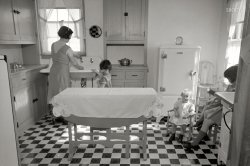
- Acme Market: 1948
- ... 1940 Plymouth, 1946 Chevrolet Fleetline, 1948 Ford, 1937 Ford.
Actually this building looks more like it Note the windows ... Posted by Dave - 11/18/2013 - 10:37am -
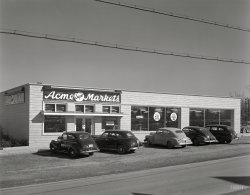
- Christmas in July: 1915
- ... Some of them date from their first Christmas together, in 1937. If I take some of their photographs and a magnifying glass, I can spot a ... a record of basically all the houses they lived in from 1937-1973 when they moved the last time.
Bells, birds, little cabins, ... Posted by Dave - 10/11/2013 - 11:01am -
![Christmas in July: 1915 "Raymond Dickey. Christmas 1915." View full size. Nat'l Photo glass negative.
OrnamentsI have a box of Christmas ornaments that belonged to my grandparents, maybe 50 years old. They're pretty well preserved, with nary a sound-chip to be had. My grandfather's method of applying tinsel was to take a fistful and hurl it at a spot on the tree.
It's interesting to see how the designs of ornaments have changed to reflect what people consider festive. I see an ear of corn, and a scary disembodied head (oer the little sailor boy's shoulder). I really like those little clip-on birds. And really, that's got to be a HUGE tree for them to sit underneath it like that.
[Below, the whole thing. - Dave]
IciclesGood ol' lead tinsel. In our house, it was required to be applied by us children--one. strand. at. a. time. or. else. My brother and I enjoyed gathering the imperfect and leftover pieces into near-lethal balls to throw at each other.
My grandparentshad the clip-on birds on their tree and I loved playing with them as a kid! Is that really an ear of corn or a German type pickle ornament?
1910 CensusWith a quick scan of the 1910 census, I found a Raymond Dickey that lived on Otis Place in Washington D.C. He's listed as a lawyer, which by the look of him, I could certainly believe. If my calculations are right, he should be about 37 in the picture. His wife, Rose, would be 36. The oldest son would be 12, and the daughter would be 9. The youngest would be below 5 since he isn't on the 1910 census. They must have been pretty well-to-do since the census lists them having two servants as well.
Ornament survivalI'm astonished. Those could be the ornaments on our tree in the 1950s. I knew we had some really old ones from my mother's family, including a couple that still had wax drippings on them, but practically all our ornaments were like this; there's at least one exact duplicate insofar as I can tell in black and white. I had no idea they were that old, or that those traditional designs were kept in production so long.
Need a Little ChristmasLike the song from "Mame" goes, "We need a little Christmas" on a currently hot and steamy NYC afternoon. The size of that tree is enormous...they were probably decorating it since Thanksgiving. I'm also with tterrace that the 30s and 50s ornaments looked identical: forever old, just as fragile.
Old OrnamentsI too have a handful of old ornaments in my possession. They belonged to my mother's parents, who are gone now. Some of them date from their first Christmas together, in 1937. If I take some of their photographs and a magnifying glass, I can spot a few of them on their tree at the time.
Luckily my grandfather had some odd habits such as photographing the interiors of every house he owned (once they'd set up) and I have a record of basically all the houses they lived in from 1937-1973 when they moved the last time.
Bells, birds, little cabins, puppies, and angels. Wonderful.
Jeepers CreepersWhere'd they get those peepers? Looks like the retoucher was a little over-zealous... I've seen other photos like this, with the pupil of the eye provided with a dot of pencil lead.
[There's no retouching here. And pencil lead applied to a negative would result in a white pupil. - Dave]
Lil' Orphan AnnieBut pencil lead to a print... or scraping a negative none too gingerly...
[Would look a uniform black, not a gradation of grays, and jagged at the edges (these are all scanned from the original glass negatives -- there are no prints). Plus their eyes look perfectly normal for an indoor shot at night. - Dave]
Tin Man OrnamentIs that a Tin Man ornament above the ear of the small boy in the sailor suit? The Wizard of Oz was published in 1900. I love this site. Thanks Dave.
(The Gallery, Christmas, Natl Photo, The Dickeys)](https://www.shorpy.com/files/images/32422u1_0.thumbnail.jpg)
- Indiana Joneses: 1904
- ... trust purchased the Harrison house at 1230 N. Delaware in 1937, to use as a "female dormitory" for conservatory students. The ... Posted by Dave - 08/10/2012 - 12:12am -
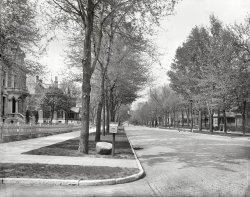
- Runt's Pool Parlor: 1939
- ... suit.
Back Door Delivery Shiny clean rear of 1937 or '38 Chevrolet Sedan Delivery reflected in window.
I am confused by ... Posted by Dave - 04/11/2021 - 1:19pm -
![Runt's Pool Parlor: 1939 November 1939. "Runt's pool parlor with poster advertising Tobacco Ball in window. Zebulon, Wake County, North Carolina." Acetate negative by Marion Post Wolcott. View full size.
Not a pool hall anymore
Alias George E StoneLooks like the sort of place Boston Blackie might wander into.
Possible Location
With a capital T and that rhymes with PTrouble right here in River City ...
Any Boob... can take and shove a ball in a pocket. And they call that sloth.
The first big step on the road to the depths of degradation.
I say, first, medicinal wine from a teaspoon, then beer from a bottle.
And the next thing you know, your son is playin' for money in a pinch-back suit.
Back Door DeliveryShiny clean rear of 1937 or '38 Chevrolet Sedan Delivery reflected in window.
I am confused by the cigarette advertising slogan on the vehicle door. Is it on the car or reflected from somewhere?
[Yes. - Dave]
Hope it was a 3 window coupe!The Tobacco Ball signage certainly drew my attention. The prospect of winning a free FORD V8 would undoubtedly have convinced me to attend.
And mosquitoes tooJudging from the size of the mesh on the screen door they must have pretty big flies in North Carolina.
Window letteringWhen I was a young sign painter, soft drink companies and breweries had healthy budgets for what is now called "point of purchase" advertising. Back then this was called "privilege panels". The beverage companies supplied the preprinted signs which usually had a blank panel to personalize the store.
Window valences were water decals applied to the interior of the glass.
If the store or tavern moved a lot of product, the salesman may allot extra for some custom lettering (Runts Pool Parlor), but not always.
If your company was able to service an account like this, you were assured of steady, although not very profitable work. As a young apprentice I was often given these jobs. Perfect environment to learn layout and speed
Runt"Runt" was probably about 6-foot-8 and weighed about 350 pounds. They had to have the double doors on the front so he could get in and out of the place.
Pine State Ice CreamWhat was being advertised by that 'Pine State' sign reflected in the window?
Eureka! Pine State Ice Cream from the Pine State Creamery in Raleigh. The brand is gone, but the building, built in 1928, is on the National Register of Historic Places.
(The pine is the official state tree of North Carolina, but Maine is officially the Pine Tree State.)
Check the 7up signnow count the bubbles.
Dental recordsThere's a reflection in the window of a sign for Dr. Massey, Dentist. He appears to have had a solo practice until his niece Zyba Massey joined him in 1954, after becoming the first female to graduate from the UNC dental school.
https://dentistry.unc.edu/2004/02/zyba-massey-first-female-graduate-of-u...
(The Gallery, M.P. Wolcott, Small Towns)](https://www.shorpy.com/files/images/SHORPY-8c35797a.thumbnail.jpg)
- The Lady Vanishes: 1940
- ... mother of invention, a new device was introduced for the 1937 model year in the United States: the car-top antenna, ideally suited for ... of the rod antenna, which Studebaker introduced in 1937.
Eventually Snyder would offer every type of antenna imaginable, but ... Posted by Dave - 05/29/2019 - 12:30pm -
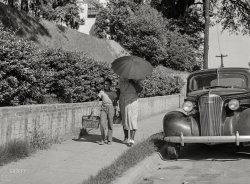
- Kentucky Akimbo: 1940
- ... West Side during the Ohio River flood of January 1937, the location of Post Wolcott's photo is at the top, just to the right of ... Posted by Dave - 04/01/2022 - 3:39pm -
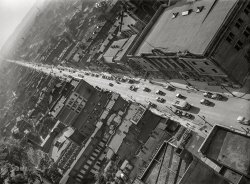
- Brattleboro Blizzard: 1940
- ... comment, I believe that snow-covered car might be a 1937 Hudson.
That Grille It's a Hudson Terraplane. Possibly a 1937.
(The Gallery, Cars, Trucks, Buses, Gas Stations, M.P. Wolcott, Small ... Posted by Dave - 05/08/2019 - 1:26pm -
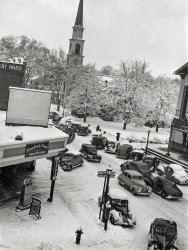
- Box Car: 1940
- ... old office building in the background, the Hill Building (1937), remains. Marion Post Wolcott would be here five months later, when she ... Posted by Dave - 05/02/2022 - 9:40am -
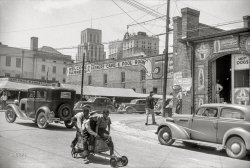
- Turning Point: 1932
- ... for cartoon characters, like Porky Pig in Tex Avery's 1937 "Picador Porky." -tterrace]
What hand signal? Not sure just what ... Posted by Cazzorla - 05/01/2016 - 2:00pm -
![Turning Point: 1932 Tom Jensen, Los Angeles police officer, chef at the Police Academy and part time actor. I scanned this photo at a family reunion for my mother's 90th birthday. He was my mother's stepmother's brother-in-law's brother. View full size.
A Bag of Nails or an Electric Washing MachineAnd handy for a nice casket right out the door and to the right. Dresslar's was located forever in Downtown Los Angeles at 1130 W. Washington, the spot where this very busy traffic photo was taken.
Mighty Turtle HumpsOkay, the trolley runs down the middle of the street and you have stations to get on it, marked by turtle shell hump dots in the pavement. So you walk across a lane of moving traffic to get into the turtle hump box, to wait for that trolley. No car would ever accidentally drive into the turtle hump box, because, as you can see, those mighty turtle humps are there to tell them not to. And no pedestrian would ever get hit crossing moving traffic, because, as this picture seems to show, even then, Los Angeles traffic was totally jammed.
So, explain to me now, why we don't use mighty turtle hump boxes. They seem to have been so "safe" for all back in 1932.
[They also came handy for cartoon characters, like Porky Pig in Tex Avery's 1937 "Picador Porky." -tterrace]
What hand signal?Not sure just what hand signal the driver at the arrow is making. I thought left hand up was for a left turn, down for a right turn, but that driver's left hand is straight out.
[That's how my father, and other drivers, signaled for a left in California in the 1950s. Arm raised aiming up was for a right and arm down was for slowing. -tterrace]
DeVauxThe pretty sedan in front of Mr Jensen was a rare bird even then, a first-rate salesman named Norman DeVaux brought a new company to market in the spring of '31 and was in receivership before a year was out, total production over two model years was a bit over 6000 cars.
Ultra rare autoThe car with the dealer plates at the right is an extremely rare 1932 DeVaux. One of them was featured in a recent issue of Hemmings Classic Cars. The car immediately behind it is an early '20s Essex built by Hudson.
Pierce-Arrowis the only car I can unequivocally identify with its distinctive fender-mounted headlights looking straight at us from the right rear of the Air Line Transfer truck.
Shorpy's De VauxA 1931 De Vaux with a 65 hp Hall engine can be seen on Shorpy here.
Turtle Humps Cont'dThey are the bane of Shriners everywhere who drive tiny cars in parades. They will flip you if you're not careful.
Next on the list is following mounted units. I'll leave it at that.
In IndianaThat's how we were taught to hand signal in the Hoosier state: Arm up (right turn), arm straight left (left turn), and arm down (slow or stop).
Safety ZoneThose "Turtle Humps" or "Mushrooms" as many call them were used extensively for numerous purposes. Some were lighted, some with reflectors and some with words like STOP. The particular one pictured had LAPD in raised letters on it, one is on display at the LAPD Museum.
I'm getting a headacheIsn't my mother's stepmother's brother-in-law's brother also my mother's stepmother's brother-in-law?
I'm getting a headache.
No Relation?If I understand correctly, this man was the brother of the man who was married to your mother's step-mother's sister.
(ShorpyBlog, Member Gallery)](https://www.shorpy.com/files/images/IMG_0011_1.thumbnail.jpg)
- Dads Say the Darndest Things!
- September 1937. "McNally family dairy farm in Kirby, Vermont. The McNallys at dinner." ...
Lucky These farmers are lucky to have electricity in 1937, as evidenced by the presence of ice cubes in their glasses. The Rural ... Posted by Dave - 11/16/2017 - 12:16pm -
![Dads Say the Darndest Things! September 1937. "McNally family dairy farm in Kirby, Vermont. The McNallys at dinner." Photo by Arthur Rothstein for the Farm Security Admin. View full size.
PunchlineDad looks like he is telling a joke. Mom and son look like they are about to laugh loudly. Great picture!!
LuckyThese farmers are lucky to have electricity in 1937, as evidenced by the presence of ice cubes in their glasses. The Rural Electric Co-op didn't reach my farm in upstate New York until 1944 (I didn't live there at the time).
#DadJokesAhhh, so's yer ol' man!
Introducing ...Edmund C. McNally (41), Edith S. (34), Robert C. (8). Not pictured are Elizabeth A. (coming in two years), a servant and three hired hands. All are Vermont natives. Edmund completed high school and Edith completed elementary school. Edmund typically works 75 hours per week. Edith will pass away in 1999 at almost 95 but she outlived her son, who died in 1981. Both outlived Edmund, who died in 1973 of heart disease. Elizabeth would live till 2006. All four stayed in Vermont till their death.
A Celebration of ?I wonder what the occasion is? This picture was cropped out of a larger one. There is an extra elbow on the table next to dad’s and an extra female hand next to mom’s. Also there are several extra place settings on the table. The young son appears to be squeezed in at the corner of the table. Dad is telling his joke to someone sitting across from him. If this is in September, could it be a Labor Day celebration?
[It's not cropped and it's not a celebration. Rothstein's assignment was to document everyday life on the McNally's farm. -tterrace]
The Irish gift of gabThis dad apparently passed on his genetic code to his son in more ways than one. They look like clones of different ages and young Robert shows definite signs of inheriting his father's ability to tell a good story, keep the blarney coming and being of good cheer always, kind of like an apprenticeship. Even mom is enjoying the entertainment and going along with Edmund's yarn which she has probably heard a hundred times. I am impressed that a family that works 75 hours a week as farmers (which means EVERYONE works that hard) still has the good nature to enjoy a meal together with enjoyable conversation. Mom also sets a nice table with lots of great depression glass and china and cares enough to provide everyone with good food. Bless all the world's farmers, the rest of us could not live without them.
The DinnerwareMount Clemens Pottery, possibly even this color Green.
(The Gallery, Arthur Rothstein, Kids, Kitchens etc.)](https://www.shorpy.com/files/images/SHORPY-8b16737a.thumbnail.jpg)
- Young Gun: 1939
- ... believe OldeRadio is correct. The radio appears to be a 1937 Silvertone 4661, seen here: ... Posted by Dave - 01/13/2013 - 8:25pm -
![Young Gun: 1939 January 1939. "Sunflower Plantation. Son of tenant farmer in corner of living room. Pace, Mississippi." Note Sonny's suction-cup ammo. Large-format nitrate negative by Russell Lee for the Resettlement Administration. View full size.
Butcher PaperTterrace we always licked the suction cups before shooting the darts usually at the tv or a window. Glass and foreheads seemed to be the only things that they would stick to.
Suction cup?We don't need no stinking suction cup. The first thing my
brother and I would do is pull the cup off and sharpen the
end in a pencil sharpener. our main targets were cardboard
boxes. I'll leave it at that.
Cool guitar!Melody King, set up for Hawaiian style playing, with the raised nut. Made in Chicago by the Harmony Co., distributed by the Bronson Co., to the best of my understanding. I collect and restore old Harmony guitars.
Streamline!Can anybody identify the toy in the box? Is it a travel trailer, or maybe a bus? And I like the ships wheel motif around the sound hole in the guitar.
No refrigerator hereToo bad because that's the only thing those darts stuck to. My uncle pronounced me "the laziest kid I have ever seen in my whole life" because I had tied thread to my darts so I wouldn't have to get up and go retrieve them.
I had one.Those suction darts would never stick to anything.
[Surely I can't be the only one who spit on the cup and stuck it to my forehead. And got a nice round blue bruise for my trouble. - tterrace]
WallPAPERI just love that "Real McCoy" wall PAPER - likely with no insulation and Tar Paper on the outside. Pity the kid did not have crayons to draw on it.
PowerlessFrom what I can see, there's probably no electricity in the house. The huge "A" battery , and the "B" battery which may be behind it on the chair, probably powered a radio among other things. The AM receiver on the table looks like it was gutted but they may have had another one. It also appears that Our Gang's "Alfalfa" was a relative.
Farm radioThe antenna and ground leads for the radio are visible just to the right of the table; the antenna lead disappears through a hole in the window frame. It's likely the radio is a Silvertone, mail-ordered from Sears and Roebuck, just like the batteries powering it. Prior to the Electrification Act of 1936 these "farm sets" were popular in rural areas; since it took several years for the "high line" to reach many farms they were still offered in the mail order catalogs in 1940.
Streamlined CampingThe toy in the shoe box is a stamped steel toy camping trailer from the All Metal Products Co. in Wyandotte, Mi. It had nickel trim and real rubber wheels.
Hopefully the kid still had the really cool LaSalle sedan that pulled the camper!
Boys and their toysLike this young lad, I also had a suction cup gun that I used to shot at anything and everything. And like this lad probably did, I found out why there was a belt hanging on the wall within easy reach of mom and dad.
Poetry FansI like how the portrait of Emily Dickinson has pride of place for this family.
Farm RadioI believe OldeRadio is correct. The radio appears to be a 1937 Silvertone 4661, seen here: http://radioatticarchives.com/radio.htm?radio=3427 Probably a nice set at that time.
(The Gallery, Kids, Russell Lee)](https://www.shorpy.com/files/images/SHORPY_8b37111a.thumbnail.jpg)
- Channel Surfing: 1956
- ... in 1953 - TV was extended to Scotland for this. The 1937 Coronation was televised, but only in the London area.
There was no ... Posted by Angus J - 11/28/2011 - 3:02pm -
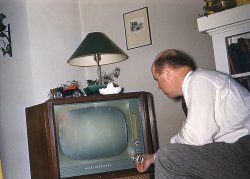
- Palace Laundry: 1925
- ... Redskins, which he moved to his hometown of Washington in 1937.
Incidentally, the Palace Laundry's slogan was "Long live linen."
... Posted by Dave - 08/08/2012 - 1:00pm -
![Palace Laundry: 1925 Washington, D.C., circa 1925. "Palace Laundry." 1811 Adams Mill Road N.W. National Photo Company Collection glass negative. View full size.
McCrory 5 & 10?Could that be a McCrory 5 & 10 on the left?
[Sanitary Grocery. - Dave]
Tree SignI've never seen a tree used as a signpost like this one -- ONE WAY DO NOT ENTER, wired about the trunk. The D.C. city traffic managers were obviously "green" long before their time.
Trendy neighborhoodThere's a BB&T bank occupying the building to the right with the arched windows. That peculiar window that's halfway in the stone facade and half in the red brick is still there. There seems to be a cafe in the buildings to the left.
View Larger Map
ParkedCan someone identify the cars?
Slight Anomalies?Two things struck me about this photo. First was the font used for the "Palace Laundry." In cursive, with all lowercase letters, it seems more like something from the 1940's or 1950's. Quite unusual, I think, for the time.
Second is the dark sedan on our left. It looks just slightly later than 1925; with its curved, not squared, roof lines, I would have guessed it as a 1927 or 1928 model.
[It could be 1928. "Circa" means "around" or "approximately." Where are the car experts? - Dave]
CarsI think both cars are GM products. The one on the left looks like a GM product from 1927-1931, it's looks similar to a 1927 Buick and the car on the right looks like a 1919 Buick. I'm not 100% sure.
[Neither one is from GM. The car on the left is a circa 1928 Studebaker Dictator. The one on the right is a Hudson. - Dave]
Cars IIThanks for the info. I thought I'd give it a shot since noone else did. I'm not too familier with '10s and '20s cars. '40s and '50s cars I can name in an instant.
Adams-MorganThis is in an area now referred to as Adams-Morgan, party central for people in their 20s. I can't recall the name of the cafe on the left but it's big with the local kickball league.
Crazy CoincidenceI was going thru the DC 1935 Addresses and found that the relative I was researching was working at the Palace Laundry then. Thanks for posting the photo.
Palace LaundryThe Palace Laundry and the Redskins have something in common -- both were owned by George Preston Marshall. In fact, Marshall's profitable laundry chain (which had more than 50 stores at its peak) enabled him to buy a pro football team, the Boston Redskins, which he moved to his hometown of Washington in 1937.
Incidentally, the Palace Laundry's slogan was "Long live linen."
The Missing Half Year & The UnknownThe first car is a 1928 1/2 Studebaker. The long hood length indicates this is actually a President 8 (the Dictator was on a much shorter wheelbase).
The 1928 1/2 year models had a new narrower radiator design and a very short visor (military style) over the windshield. The wheels are also unusual, but they are not unique to this year (they were definitely available in 1927 and both 1928 model years).
The 1929 closed Studebaker models had a curved "A" post at the windshield so it is easy to identify this as a 1928 1/2 year model.
The second car does not appear to be a Hudson. On almost all Hudson's the Hudson triangle is visible on the hubcaps. I cannot see any here (but the photo also does not show the hubcaps as clearly as I would like). Also, the front of the grill should have a flat portion below the corporate logo for a Hudson. Lastly, I cannot find any pictures of a Hudson with the large number of vertical louvers on the hood as seen here.
I would have guessed the second car as a Lincoln, but the grill also does not match. I have not been able to determine the exact make of the second car.
(P.S. Based on the previously posted information should the title be updated to reflect the year 1928 or 1929 as well as the caption?)
Not a StudebakerThe first car is definitely NOT a Studebaker of any year or model. Nothing matches up including body shape, cowl lights radiator shell. Not sure what it is, but sure what it isn't!
Disc wheelsThe large car with the disc wheels is a 1929 Nash. Their ad stressed the fact that their motor had seven main bearings making it exceptionally smooth.
(The Gallery, Cars, Trucks, Buses, D.C., Natl Photo, Stores & Markets)](https://www.shorpy.com/files/images/18188u.thumbnail.jpg)
- Where's the Ticket Window?
- ... who care, is C&O Pacific type #492. Photo dated July, 1937. View full size.
Locomotive Portrait Hard to say who took the ... Posted by Lost World - 09/23/2011 - 12:05am -
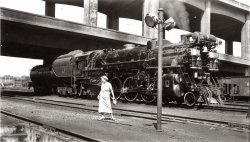
- Little Kittens: 1941
- ... months.
Cool Car Cold Water The car looks to be a 1937 Chevrolet Sport Coupe (with a rumble seat!) and the cold water inlet ... Posted by Dave - 01/17/2021 - 1:32pm -
![Little Kittens: 1941 March 1941. "Girls at trailer camp for defense workers. Ocean View, Virginia, outskirts of Norfolk." Medium format acetate negative by John Vachon. View full size.
Trying, but failingTo understand the gizmo attached to the bottom of the rear fender on the closest bike. It looks like there is one on the other bike, too.
[It's a kickstand. - Dave]
Well, of course it is. Pretty obvious. Thanks, Dave.
Sweet kidsThat girl in the back is beautiful. She could be a model. I wonder how their lives turned out.
Charming childrenWhat beautiful faces and expressions. The joy of the one with the little book is almost palpable. Some are born to sweet delight.
HappyOnce in a while you see a photo that just makes you happy.
This is one of them !
Wonder womenThese three girls are so charming and elegant, each in her own way. The windswept hair of the young lady in back is terribly alluring, and the kerchief with braids and leather gloves in front is so grown-up. Even little kitten girl is styling with that hand-knotted cloth belt. All three are so pleasing.
Collector's itemIf the young lady who was so proud of her copy of "More About the Four Little Kittens" had taken good care of it, and saved it to this day, she could do quite well selling it online. If my math is right, if she sold it today based on its market price, she could reinvest the proceeds in a Patreon subscription to Shorpy, avoiding ads and getting background versions of pics for three years and four months.
Cool Car Cold WaterThe car looks to be a 1937 Chevrolet Sport Coupe (with a rumble seat!) and the cold water inlet appears to be a hose attached at the clothes line. The young girls are probably sisters. One of them is riding a boys bike but the boy (brother?) is probably okay with it.
I hope no kittens were mistreated."More about the Four Little Kittens" (1938), one of those controversial books by Harry W. Frees that allegedly involved stressful posing of live pets. Delightful for kids, maybe not so much for the kitties.
https://www.barnebys.com/auctions/lot/3_kaqz_69
HeavyThose bikes look like a lot of steel to be pedaling around. I wonder how much they weighed.
Everything to MeFood, shelter, clothing, love and care are essentials but add a bike and books, and life gets pretty close to perfect, and certainly makes other hardships much easier to bear.
Bloody boat anchorsfreddy223, the answer to your question is "between 40 and 50 pounds" (18 to 22 kg). My late mother owned a bike identical to the front one, and it was a trial and a misery to ride due to its weight.
Five window coupeCurvaceous 1935 Ford, showing off it's its well-polished paint.
(The Gallery, Bicycles, Cats, John Vachon, Kids, Norfolk, WW2)](https://www.shorpy.com/files/images/SHORPY-8c18993a.thumbnail.jpg)
- Sand Reef: 1942
- ... To the delight of the tabloid press, in December 1937 she divorced Stokowski in Las Vegas and a few weeks later married Prince ... Posted by Dave - 08/28/2022 - 9:49pm -
![Sand Reef: 1942 January 14, 1942. "Prince and Princess Alexis Zalstem-Zalessky, residence in Palm Beach, Florida. Miss Knoop, Mr. Wessel, Prince (standing) and Princess on beach. Treanor & Fatio, architect." 5x7 inch acetate negative by Gottscho-Schleisner. View full size.
Palm Beach Notes 1.15.42
Cool house ... cool swimming attireI remember as a kid, my dad wearing the matching swimsuit gear...although I don't think his was as hip as the guy in the photo. I bet at least one of the gents is wearing brown wingtip shoes. I'm curious about the bamboo pole. Is it being used as a flagpole? But you'd think it wouldn't be leaning like that and if the line coming from the top down to his hand was the flag halyard, it would be a continuous loop, a pulley being at the top. So is it just a cane pole for fishing???
[Sometimes I really wonder about you people. - Dave]
LOL ... pretty damn scary.
I recognize two namesMme. Louis Jacques Balsan was born Consuelo Vanderbilt. Before Balsan she married Charles Spencer-Churchill, 9th Duke of Marlborough. The duke wanted her money; Consuelo's mother wanted a duchess daughter. Even though Consuelo's first marriage was very unhappy, she is buried near Blenheim Palace; not on Staten Island with the other Vanderbilts, not next to her much-beloved second husband.
Elsa Maxwell was a society hostess, and a lot more. Read her Wikipedia page. She was very much a self-made woman. She testified in the Claus von Bülow attempted murder trial of his socialite wife. I remember film footage where Elsa was asked about Newport, Rhode Island social life.
[Ms. Maxwell died in 1963 -- you're confusing her with someone elsa. - Dave]
Damn! I have a very clear image of the film footage and her testimony. I can't find it on the Internet; therefore, it must not exist ... plus, she was dead.
Maurice Fatio was a very popular architect, both in Palm Beach and New York City. He and his wife were among the dinner guests. Of his work I could find, the Prince and Princess's home is relatively modern and modest. I couldn't locate their house on the beach and doubt it's extant. At the other end of the spectrum, the house he designed for the Balsans is more typical of his work and very much still there.
I wondered just where the prince hailed from. willc supplied Russia. I also found this:
Evangeline became a princess, wife of Prince Alexis Zalstem-Zalessky. In 'Crazy Rich: Power, Scandal, and Tragedy Inside the Johnson & Johnson Dynasty', Jerry Oppenheimer describes the prince as “of dubious royal lineage … better known in certain circles as basically a charming gigolo.”
Interestingly, guest and artist Guitou Knoop was also Russian, born in Moscow in either 1902 or 1909, depending on the source.
"Lady Bountiful Sues Prince as Bad Boy"Newspaper social pages and wire service gossip columns regularly featured snippets about the glamorous doings of the charismatic former Russian Prince and his Princess, whose lives and social prominence in the late 1930s and 1940s furnished popular character types for screwball comedies on Broadway and in the movies.
Born in 1897, Evangeline Brewster Johnson was a wealthy Johnson & Johnson pharmaceutical company heiress, whose first husband was Philadelphia Orchestra conductor Leopold Stokowski. To the delight of the tabloid press, in December 1937 she divorced Stokowski in Las Vegas and a few weeks later married Prince Alexis in Phoenix. Their marriage endured until the Prince's death in 1965, despite another cringe-worthy tabloid episode in May 1940 that appeared in dozens of papers from New York to California. Here is the New York Daily News rendition.
More social notes: degrees of separationExpanding on willc's account of the marital adventures of Johnson & Johnson heiress Evangeline Brewster Johnson:
After Evangeline left celebrity conductor Leopold Stokowski for her dubious prince, Stokowski promptly carried out a well-publicized liaison with Greta Garbo, then a few years later married Gloria Vanderbilt, who was 42 years his junior and 27 years younger than Evangeline. That marriage lasted 10 years, one less than Leopold's with Evangeline. Leopold's two sons with Gloria, Stan and Christopher, are half-brothers of Evangeline's daughters Gloria Luba and Andrea Sadja, and also half-brothers of Anderson Cooper.
Evangeline lived to 93, Leopold and Gloria both to 95.
(The Gallery, Florida, Gottscho-Schleisner, Swimming)](https://www.shorpy.com/files/images/SHORPY-5a08121u.thumbnail.jpg)
- Small Business: 1940
- ... the play Hay Fever, which newspaper clippings from 1937 also mention. Hay Fever must have been an annual tradition at the school. ... Posted by Dave - 08/01/2012 - 2:30pm -
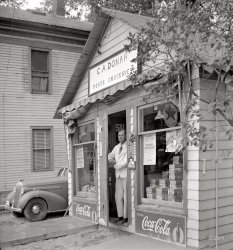
- Local Traffic: 1941
- ... I remembered, it was a John Deere model "L," produced from 1937 to 1946. It replaced thousands of farm horses.
The former not the ... Posted by Dave - 02/03/2019 - 5:52pm -
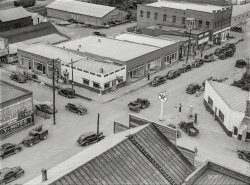
- Winter Sports: 1940
- ... Story." The only things missing are the driveway and the 1937 Oldsmobile (and the Leg Lamp!).
Get off my lawn That's what's wrong ... Posted by Dave - 12/27/2012 - 7:50pm -
